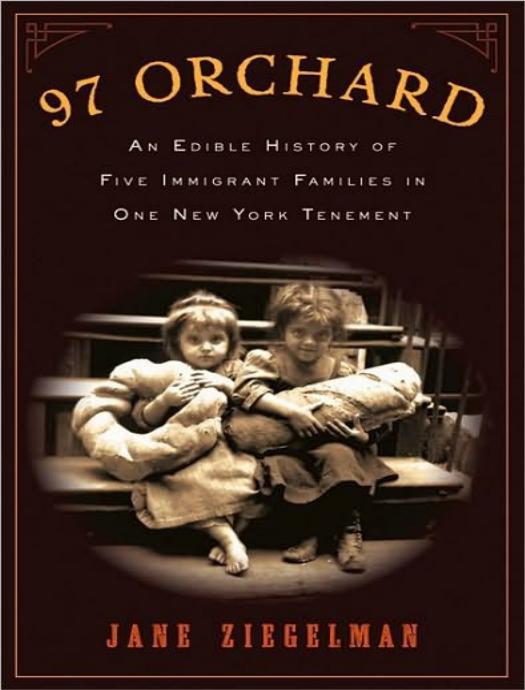97 Orchard: An Edible History of Five Immigrant Families in One New York Tenement by Jane Ziegelman

Author:Jane Ziegelman
Language: eng
Format: mobi, epub, pdf
Tags: History: American, United States - State & Local - General, Cooking, United States - 19th Century, Social History, Lower East Side (New York, Emigration & Immigration, Social Science, Nutrition, New York - Local History, New York, N.Y.), State & Local, Agriculture & Food, Food habits, Immigrants, United States, Middle Atlantic, 19th century, History, General, History - U.S., United States - State & Local - Middle Atlantic, New York (State)
ISBN: 9780061288500
Publisher: HarperCollins
Published: 2010-06-02T10:33:30.980000+00:00
The immigrants’ dining room at Ellis Island, date unknown.
National Archives
Like the baggage-handlers and money-changers, the Ellis Island food purveyors were private contractors granted the privilege of doing business on government property, hence their generic title: “privilege holders.” Of all the island’s concessions, feeding the immigrants was the most lucrative, and local caterers competed for the job in public auctions. The results were announced in the local papers, like the final score in a sporting event. Along with running the dining room, the food concessionaire operated a lunch stand, where immigrants paid cash for bread, sausage, tins of sardines, fruit, and other portable items. In the dining room, the immigrant ate for free, the food paid for by the steamship companies that brought them to America. In 1902, that came to 35 cents a day for breakfast, lunch, and dinner, a small sum that added up quickly. During the high-volume years, feeding the immigrants detained on Ellis Island cost the steamship companies half a million dollars annually, but the money came out of the terrific profits they made on their steerage passengers, the golden goose of the shipping industry.
The immigrants’ first lesson in American food ways, however, took place before they had even landed. Once their ship had docked, the immigrants were loaded onto barges that ferried them to Ellis Island. It was here that each passenger was handed a cup of cider and a small round pie, the quintessential fast food of turn-of-the-century America. The two foods that most impressed the new immigrants were bananas (many tried to gnaw through the skin) and sandwiches. As they waited their turn in the Ellis Island registry line, sometimes a thousand people long, waiters snaked through the crowd, distributing coffee and ham or corned-beef sandwiches. The immigrants munched appreciatively, marveling over the sweetness of American white bread.
The regimen in the Ellis Island dining room was meager and repetitive, a step up from prison fare. For breakfast, there was bread and bowls of coffee with milk and sugar. At lunch, the immigrants were given soup, boiled beef, and potatoes. For supper, more bread, this time with the addition of stewed prunes. Unscrupulous caterers and crooked officials conspired to winnow the big-ticket items (the meat and the dairy) from the immigrants’ diet until all that was left was bread, coffee, and prunes. As a result, thousands of immigrants sustained themselves on an innovation of the Ellis Island kitchen: the prune sandwich.
In 1903, President Roosevelt launched an investigation into corruption on Ellis Island, which ended with a thorough overhaul of the reigning administration. One beneficiary of the regime change was the immigrant dining room. Menus tell the story best. The one below is from a later period, but captures the reformers’ culinary mandate:
Download
97 Orchard: An Edible History of Five Immigrant Families in One New York Tenement by Jane Ziegelman.epub
97 Orchard: An Edible History of Five Immigrant Families in One New York Tenement by Jane Ziegelman.pdf
This site does not store any files on its server. We only index and link to content provided by other sites. Please contact the content providers to delete copyright contents if any and email us, we'll remove relevant links or contents immediately.
Craft Beer for the Homebrewer by Michael Agnew(17461)
Marijuana Grower's Handbook by Ed Rosenthal(3122)
Barkskins by Annie Proulx(2884)
Project Animal Farm: An Accidental Journey into the Secret World of Farming and the Truth About Our Food by Sonia Faruqi(2667)
Red Famine: Stalin's War on Ukraine by Anne Applebaum(2467)
The Plant Messiah by Carlos Magdalena(2458)
Organic Mushroom Farming and Mycoremediation by Tradd Cotter(2313)
0041152001443424520 .pdf by Unknown(2228)
In the Woods by Tana French(2005)
Beer is proof God loves us by Charles W. Bamforth(1935)
The Art of Making Gelato by Morgan Morano(1901)
Meathooked by Marta Zaraska(1893)
Birds, Beasts and Relatives by Gerald Durrell(1869)
Reservoir 13 by Jon McGregor(1856)
The 7 Habits of Highly Effective People: Powerful Lessons in Personal Change (25th Anniversary Edition) by Covey Stephen R(1839)
Borders by unknow(1790)
The Lean Farm Guide to Growing Vegetables: More In-Depth Lean Techniques for Efficient Organic Production by Ben Hartman(1789)
The 7 Habits of Highly Effective People: Powerful Lessons in Personal Change by Stephen R. Covey(1767)
Urban Farming by Thomas Fox(1751)
